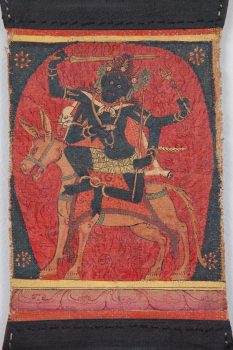Tibet
14th century
A skull cup is an attribute of tantric deities and is usually paired with a curved knife. It can symbolize a mind filled with the bliss of realizing the true nature of reality.
Tibet
14th century



In this small gem of a painting the dark main deity is set against a horseshoe shaped halo of whirling flames. The agitated movement of this wrathful goddess contrasts with the rather static profile depiction of her mount. Remarkable is the patterning of the human skin that forms her saddle, the elephant skin flayed behind her, and her clothing, which appears to be an abstraction of wickerwork. Most telling in terms of attribution are the high, flat hair knot and the long and slim triangular ornaments seen in the crown and the bracelets. The yellow border and the dark-blue background featuring large blossoms are characteristic of the period. In this early representation of Palden Lhamo peaceful and wrathful features are combined. While her facial expression is extremely wrathful, with fangs in her mouth, the goddess wears a dhoti and also jewelry. The goddess has four arms and brandishes a sword and a tantric staff in her upper hands and a skull cup and a staff with a peacock feather in her lower ones. She sits sideways on her mount, and her legs are chained together. Her saddle is a human skin. She likely represents a form of the “smoke-clad” goddess Dusolma, although she does not possess all of the characteristics found in textual descriptions of that goddess.
A virtuous feeling and deep respect toward an authentic teaching, teacher, or path. Buddhists believe that expansive study, analysis, and meditation are essential steps for cultivating a healthy and enduring devotion.
Buddhist practitioners in some traditions believe that cutting through ordinary perceptions that keep us in the endless cycle of death and rebirth, known as samsara, can create a powerful and enhanced divine identity that leads to enlightenment.
Prescribed practices that carry symbolic meaning and value within a specific tradition and are intended to attain a desired outcome. Rituals are usually done as part of a ceremony or regular routine.
Protectors of Buddhist teachings who destroy obstacles that impede the path to enlightenment. The more frightening and gruesome their appearance, the greater their power.
Today, Tibetans primarily inhabit the Tibetan Plateau, situated between the Himalayan mountain range and the Indian subcontinent to the west, Chinese cultural regions to the east, and Mongolian cultural regions to the northeast. During the 7th to 9th century, Tibetan rulers expanded their empire across Central Asia, and established Buddhism as the state religion.
Get the latest news and stories from the Rubin, plus occasional information on how to support our work.